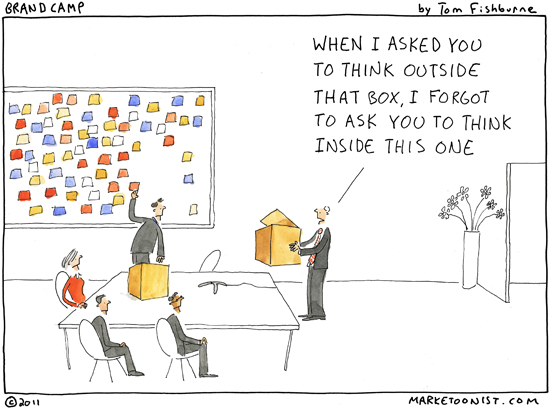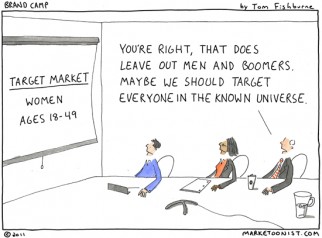All innovation occurs in some kind of box. It’s always framed by some constraint, whether from the organization, the marketplace, or the consumer.
In some cases, those constraints can spark even greater creativity. They can provide focus and a tangible challenge to rally the team. Think about the famous scene in Apollo 13, when an engineer briefed the team trying to save the astronauts: “We’ve got to find a way to make this [square CSM LiOH canister] fit into the hole for this [round LEM canister] using nothing but that [spare parts on board the ship].”
Yet some constraints can preemptively hamper innovative thinking. It all depends on the size of the box.
I once attended a “blue sky ideation” for a 120 year old brand of baking flour. We started out with freeform brainstorming and quickly realized that we were limited in just about every dimension (no new SKUs, no new sizes, no new ingredients, etc.). An idea to package the flour in milk cartons to prevent spills when pouring was vetoed because we couldn’t change the line equipment.
It turned out that the “blue sky ideation” wasn’t “blue sky” at all. We weren’t allowed to step beyond the very small box that currently contained the brand. No wonder they hadn’t had a major innovation since 1979. With those constraints, why bother having an ideation at all?
As Innovation Professor Tim Kastelle wrote. “‘Think outside the box’ usually means ‘make a small jump that will move one edge of the box out just a tiny bit’.”
(Marketoonist Monday: I’m giving away a signed print of this week’s cartoon. Just share an insightful comment to this week’s post. I’ll pick one comment at 5:00 PST on Monday. Thanks!)



Kevin McFarthing says
Great post, Tom. The surest way to demotivate idea generation participants is to build expectations then squash them with surprising constraints. It’s much better to have a clear target for the brainstorm, clearly explain the scope, then let them work at it. The other important point is to explain what will happen to the output. All too often brainstorms produce ideas which either immediately or gradually fade into useless obscurity…… Be clear what you will do with the output, and stick to your commitment.
Tim Kastelle says
Very good post Tom, and thanks for the mention!
Your blue sky ideation story rings very true to me. I’ve had similar experiences. I was once asked to redesign a process starting with “a blank sheet of paper”. It was only after I did as asked that in fact, the paper I was supposed to be using had a fair bit of marking on which couldn’t possibly be erased.
Frustrating, sometimes…
Ken LeClair says
I enjoyed the cartoon and commentary. It makes me think about poetry and how often times it is easier to be creative when constrained by a specific structure (e.g., sonnet) than it is to write in free form with only your imagination to guide you.
-Ken
Martin Chillcott says
Truly great creativity is often within constraints. Think of Beethoven and any one of several other maestros who created music that has lasted generations, but was composed within a Symphonic structure. Or perhaps the many black American blues artists from the 1920s to 60s who each created their own distinctive sound, but within a blues 12 bar format (although John Lee Hooker often added in a 13th!)Anyone can have a blue sky session “Oooh, how about hover scooters for customers or James Bond jet packs”. Clear parameters , but with a little blue sky ‘loosener’ session to get the minds going usually does it and projection techniques even better i.e. “What would Richard Branson/Lady Gaga/Steve Jobs/Nelson Mandela etc do in this situation” Question. Was it the ‘Post it note’ manufacturers who encouraged ‘Blue sky’ thinking?!!
Mike Talbot says
I always consider the phrase “thinking outside the box” to work best in terms of the Candle problem – ably demonstrated from 2min – 3min in this excellent Ted talk http://www.ted.com/talks/dan_pink_on_motivation.html
Whilist I don’t know what the connection to the phrase “thinking outside the box” and the Candle problem’s “functional fixedness” is exactaly, it does seem pretty strong.
And I totally agree that great innovation comes from pushing against constraints – not by completely removing them. Music and poetry are great examples of this: without the strict structural forms imposed, any word or note is possible and the result is most mediocre at best.
Nannette Stangle-Castor says
Excellent post Tom. It seems to me that with the increased focus on innovation, your post is very timely. With the rush to jump on the innovation bandwagon, the practical aspect of having to implement innovative ideas is lost. Innovation attempts without acknowledgment of the constraints that exist within the particular innovation ecosystem are not going to result in tangible innovation. Thanks for presenting that so well!
Ashley Carneal says
Great post, Tom – presented in a funny, quippy – and truthful manner! I can’t begin to tell you how many innovation brainstorming sessions I attend where we spend more time in the upfront talking about the constraints more so than the actual ‘storming – everyone is so deflated at that point! If I have to hear one more time “We have to design this within XX cost, or else WalMart won’t take it and we won’t have the volumes,” I will lose it! I can’t help but wonder tho – are these constraints really real, or are we just so programmed to operate on our default thinking? Thanks again!
Sharlene Sones says
I can’t even think about the box, I’m too busy trying to “take it to another level.” 🙂
John Ruetten says
What I find interesting about this cartoon and the idea of “thinking outside the box” is that the product or company brand is the “box.” Good brands (by their nature) are both powerful and constraining. In fact, the focus and constraints are necessary for the brand to be successful. So, thinking outside the box is arguably best done when creating a new brand. If we are trying to revitalize a current or older brand, maybe we should be reviewing what made the brand successful in the first place, or assesing if the brand’s useful life is over. This is especially true in a world where the pre-occupation with advertising can cause marketing managers to lose touch with the essence of a brand – The tangible ideas that actually cause customers to come back for more.
tomfishburne says
Thanks, everyone, for such inspiring commentary this week. I’ve given a lot of thought to the pendulum of too little and too many constraints in innovation and I loved your insights.
I particularly like the analogy of poetry sonnets and 12 bar blues raised by Ken and Martin. Those are great examples, as brainstorming without constraints can lead to outlandish ideas like “hover scooters” for customers. Those ideas are more likely to end of up unused, sitting in boxes, as Kevin described.
I’ve been meaning to draw a cartoon on the warehouse of old brainstorm notes that never go anywhere.
This week’s cartoon print goes to Mike. I hadn’t seen that Ted talk he shared (http://www.ted.com/talks/dan_pink_on_motivation.html) but I think the Candle problem captures the elusive tension of the importance of structure, with flexibility to see that structure in a different light.
That Ted talk also leads to the issue of motivation and how to inspire teams to think creatively. The conclusions are different that you might think. Well worth the watch.
Richard says
Mate your cartoons are absolutely brilliant. On the money. Insightful. Funny. Keep up the great work. Richard 🙂
Greg S. says
Great article. Yet, I had a professor who LOATHED the saying “Think outside the box.” When one tries to do so, he or she is still constrained by and measured by the box itself.